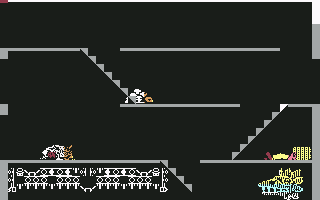Retro Replay Review
Gameplay
Aztec offers a tight blend of action and adventure as you guide your intrepid explorer through a sprawling, trap-filled maze in search of the legendary Jade Idol. Armed only with a pistol and three sticks of dynamite, every decision feels critical: should you risk confronting a panther head-on or lure it into a trap with your last explosive? The controls are straightforward yet flexible, allowing for running, shooting, placing dynamite, and interacting with environmental objects, which lends a strong sense of agency to your journey.
(HEY YOU!! We hope you enjoy! We try not to run ads. So basically, this is a very expensive hobby running this site. Please consider joining us for updates, forums, and more. Network w/ us to make some cash or friends while retro gaming, and you can win some free retro games for posting. Okay, carry on 👍)
The game’s difficulty is tied directly to the value of the Jade Idol, creating a rewarding risk–reward loop: grab the idol quickly on an easier skill level and you earn a higher score, but tackling the same challenge on harder settings lets you test your mettle against faster, more numerous enemies. As you advance through the eight available skill levels, snakes, panthers, and hostile natives become more aggressive and stealthy, forcing you to constantly adapt your strategy and make clever use of your limited resources.
Exploration is at the core of Aztec’s gameplay loop. You’ll open crates and sift through “trash piles” in search of machetes, bullets, health potions, or, if luck is on your side, the prized Jade Idol itself. However, not every container is a treasure trove—some yield nothing but bones or skulls—so the tension of discovering each new object keeps the experience fresh. And if you meet an untimely end, the game’s forgiving restart feature drops you right back into the same maze, preserving your hard-earned knowledge of its twists and turns.
Graphics
For its era, Aztec boasts surprisingly fluid animations and a colorful, atmospheric art style. Each creature—whether slithering snake, prowling panther, or wary native—comes to life through multiple animation frames, giving the maze’s inhabitants an organic feel rarely seen in contemporaneous titles. These details help reinforce the dangers lurking around every corner and pull you deeper into the game’s hazardous world.
The maze itself is rendered with clear, readable tiles that subtly change as you descend to lower levels, creating a strong sense of progression and exploration. While the walls and floors remain relatively simple in design, cleverly placed environmental cues—like collapsing ceilings, shifting walls, or hidden doorways—add excitement and occasional surprises. The limited color palette still manages to convey the oppressive heat and mystery of an ancient temple complex.
Special effects are modest but effective: torches flicker, dynamite flashes light up dark corridors, and character sprites cast small shadows that enhance the illusion of depth. Even on higher difficulty levels, where the action intensifies, the frame rate remains stable and responsive, ensuring that split-second decisions—such as dodging a falling ceiling or lining up a perfect shot—are executed without frustrating lag or slowdown.
Story
Aztec positions you as a daring treasure hunter in the mold of classic pulp heroes, channeling the spirit of Indiana Jones as you infiltrate a deadly underground labyrinth. Although the narrative is lean—focused primarily on acquiring the Jade Idol and escaping alive—the setting and premise are vivid enough to spark your imagination. Every crate you open could hold clues to the temple’s history or just serve as bait for lurking predators, reinforcing the theme of uncertainty that runs through the entire adventure.
Rather than unfolding through lengthy cutscenes or dialogue, the story emerges organically via environmental storytelling: hieroglyphic-laden walls hint at ancient rituals, abandoned campsites suggest previous explorers who didn’t make it out, and the Idol itself changes in perceived value according to the difficulty chosen at the outset. This minimalist approach keeps the pace brisk and allows players to project their own heroic fantasies onto the protagonist, boosting immersion.
Occasional set-piece moments—such as walls converging to crush the hero or ceilings slowly lowering—feel like chapters in an action serial, each requiring quick reflexes and keen observation. While Aztec doesn’t delve deeply into character backstory or complex plot twists, its straightforward narrative framework provides just enough context to drive you forward, room by room, toward your ultimate goal.
Overall Experience
Aztec delivers a compelling old-school adventure that balances action, puzzle-solving, and exploration in a way that still holds up today. The thrill of navigating treacherous corridors, the satisfaction of outsmarting cunning enemies, and the exhilaration of recovering the Jade Idol combine to create a highly replayable experience. Whether you’re a newcomer to classic action-adventure games or a seasoned veteran, this title offers both comfortingly familiar mechanics and enough challenge to keep you invested.
Although some players may find the highest difficulty levels nearly insurmountable, the ability to choose from eight skill settings ensures a tailored experience for casual explorers and hardcore gamers alike. The option to restart in the same maze preserves your progress, mitigating frustration and encouraging experimentation. Moments of tension—like evading a hungry jaguar in a narrow tunnel—are balanced by the satisfaction of uncovering hidden pathways or discovering a well-hidden cache of dynamite.
In sum, Aztec stands as a testament to smart game design that maximizes limited hardware resources. Its engaging gameplay loops, atmospheric graphics, and adventure-driven story combine into an immersive package that holds up remarkably well decades after its release. For anyone in search of a challenging, treasure-seeking romp through booby-trapped temples and snake-infested corridors, this title is an experience worth unearthing.
 Retro Replay Retro Replay gaming reviews, news, emulation, geek stuff and more!
Retro Replay Retro Replay gaming reviews, news, emulation, geek stuff and more!









Reviews
There are no reviews yet.